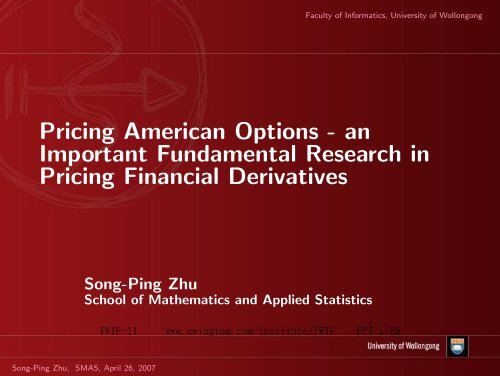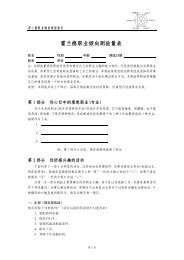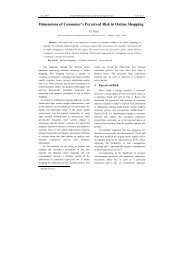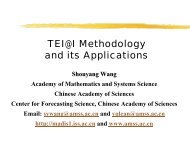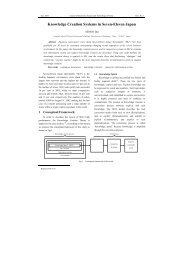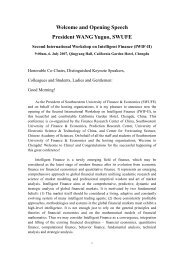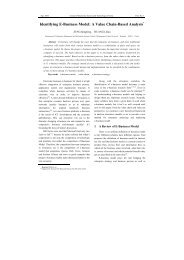Pricing American Options - an Important Fundamental Research in ...
Pricing American Options - an Important Fundamental Research in ...
Pricing American Options - an Important Fundamental Research in ...
Create successful ePaper yourself
Turn your PDF publications into a flip-book with our unique Google optimized e-Paper software.
Faculty of Informatics, University of Wollongong<br />
<strong>Pric<strong>in</strong>g</strong> <strong>Americ<strong>an</strong></strong> <strong>Options</strong> - <strong>an</strong><br />
Import<strong>an</strong>t <strong>Fundamental</strong> <strong>Research</strong> <strong>in</strong><br />
<strong>Pric<strong>in</strong>g</strong> F<strong>in</strong><strong>an</strong>cial Derivatives<br />
Song-P<strong>in</strong>g Zhu<br />
School of Mathematics <strong>an</strong>d Applied Statistics<br />
IWIF-II www.sw<strong>in</strong>gtum.com/<strong>in</strong>stitute/IWIF PPT 1/68<br />
Song-P<strong>in</strong>g Zhu, SMAS, April 26, 2007
Outl<strong>in</strong>e<br />
Outl<strong>in</strong>e of the talk<br />
A Review of <strong>Pric<strong>in</strong>g</strong> <strong>Americ<strong>an</strong></strong> <strong>Options</strong><br />
An exact <strong>an</strong>d explicit solution for <strong>Americ<strong>an</strong></strong> put<br />
options<br />
Examples <strong>an</strong>d Discussions<br />
Conclud<strong>in</strong>g Remarks<br />
IWIF-II www.sw<strong>in</strong>gtum.com/<strong>in</strong>stitute/IWIF PPT 2/68<br />
Song-P<strong>in</strong>g Zhu, SMAS, April 26, 2007 0-1
Background<br />
What is <strong>an</strong> option?<br />
What is a Europe<strong>an</strong>-style option?<br />
What is <strong>an</strong> <strong>Americ<strong>an</strong></strong>-style option?<br />
What is the optimal exercise price of <strong>an</strong> <strong>Americ<strong>an</strong></strong><br />
option?<br />
What is f<strong>in</strong><strong>an</strong>cial <strong>in</strong>terpretation of the optimal<br />
exercise price of <strong>an</strong> <strong>Americ<strong>an</strong></strong> option?<br />
IWIF-II www.sw<strong>in</strong>gtum.com/<strong>in</strong>stitute/IWIF PPT 3/68<br />
Song-P<strong>in</strong>g Zhu, SMAS, April 26, 2007 0-2
Review of Various solution Approaches<br />
Analytical Approximation Methods<br />
Numerical Solutions<br />
Analytical Exact Solutions<br />
IWIF-II www.sw<strong>in</strong>gtum.com/<strong>in</strong>stitute/IWIF PPT 4/68<br />
Song-P<strong>in</strong>g Zhu, SMAS, April 26, 2007 0-3
Review of Various solution Approaches<br />
Numerical Approaches:<br />
Directly solv<strong>in</strong>g PDE:<br />
– Brenn<strong>an</strong> <strong>an</strong>d Schwartz (1977), Wu <strong>an</strong>d Kwok (1997): F<strong>in</strong>ite<br />
Difference Method (FDM);<br />
– Allegretto et al. (2001): F<strong>in</strong>ite Element Method (FEM);<br />
– Forsyth <strong>an</strong>d Vetzal (2002): F<strong>in</strong>ite Volume Method (FVM);<br />
– Hon <strong>an</strong>d Mao (1997): Radial Basis Function Method (RBF);<br />
– Benth et al. (2004): Semil<strong>in</strong>ear Approach;<br />
– Rodolfo (2007): Cubic Spl<strong>in</strong>es Approach;<br />
– Zhu <strong>an</strong>d Zh<strong>an</strong>g (2007b): Predictor-Corrector Scheme.<br />
IWIF-II www.sw<strong>in</strong>gtum.com/<strong>in</strong>stitute/IWIF PPT 5/68<br />
Song-P<strong>in</strong>g Zhu, SMAS, April 26, 2007 0-4
A Numerical Example Used <strong>in</strong> Zhu <strong>an</strong>d Zh<strong>an</strong>g<br />
(2007b)<br />
Strike price X = $100,<br />
Risk-free <strong>in</strong>terest rate r = 0.1,<br />
Volatility σ = 0.3,<br />
Time to expiry T = 1 (year).<br />
IWIF-II www.sw<strong>in</strong>gtum.com/<strong>in</strong>stitute/IWIF PPT 6/68<br />
Song-P<strong>in</strong>g Zhu, SMAS, April 26, 2007 0-5
A Figure <strong>in</strong> Zhu <strong>an</strong>d Zh<strong>an</strong>g (2007b)<br />
100<br />
95<br />
O<br />
Zhu <strong>an</strong>d Zh<strong>an</strong>g’s numerical solution<br />
Zhu(2006b)’s <strong>an</strong>alytical solution<br />
Optimal Exercise Price ($)<br />
90<br />
85<br />
80<br />
75<br />
0 0.1 0.2 0.3 0.4 0.5 0.6 0.7 0.8 0.9 1<br />
Time to Expiry (Year)<br />
A comparison of optimal exercise prices with two different<br />
approachesIWIF-II www.sw<strong>in</strong>gtum.com/<strong>in</strong>stitute/IWIF PPT 7/68<br />
Song-P<strong>in</strong>g Zhu, SMAS, April 26, 2007 0-6
A Figure <strong>in</strong> Zhu <strong>an</strong>d Zh<strong>an</strong>g (2007b)<br />
0.8<br />
N=200<br />
0.7<br />
0.6<br />
M=100<br />
M=80<br />
M=60<br />
CPU Time (second)<br />
0.5<br />
0.4<br />
0.3<br />
0.2<br />
0.1<br />
N=10<br />
0<br />
0 1 2 3 4 5 6 7 8 9<br />
RMSRE (%)<br />
Accuracy vs. Efficiency<br />
IWIF-II www.sw<strong>in</strong>gtum.com/<strong>in</strong>stitute/IWIF PPT 8/68<br />
Song-P<strong>in</strong>g Zhu, SMAS, April 26, 2007 0-7
Review of Various solution Approaches<br />
Numerical Approaches:<br />
Risk Neutral Approaches<br />
– Cox et al. (1979): The B<strong>in</strong>omial Method<br />
– Gr<strong>an</strong>t et al. (1996): The Monte Carlo simulation method<br />
– Longstaff <strong>an</strong>d Schwartz (2001): the Least Squares Method<br />
(Monte Carlo simulation)<br />
IWIF-II www.sw<strong>in</strong>gtum.com/<strong>in</strong>stitute/IWIF PPT 9/68<br />
Song-P<strong>in</strong>g Zhu, SMAS, April 26, 2007 0-8
Review of Various solution Approaches<br />
Numerical Approaches:<br />
Risk Neutral Approaches<br />
Under the risk neutral argument, the current value of <strong>an</strong>y<br />
f<strong>in</strong><strong>an</strong>cial derivative is equal to the expected return at the<br />
expiry discounted to the present time.<br />
IWIF-II www.sw<strong>in</strong>gtum.com/<strong>in</strong>stitute/IWIF PPT 10/68<br />
Song-P<strong>in</strong>g Zhu, SMAS, April 26, 2007 0-9
Review of Various solution Approaches<br />
Zhu <strong>an</strong>d Fr<strong>an</strong>cis (2004) found <strong>an</strong> improved algorithm to<br />
calculate the critical exercise price.<br />
Table 1. Convergence of the B<strong>in</strong>omial Method<br />
Method<br />
Optimal Exercise Price at Expiry<br />
B<strong>in</strong>omial n=10 78.93<br />
B<strong>in</strong>omial n=100 77.18<br />
B<strong>in</strong>omial n=1000 76.51<br />
Zhu (2006b) 76.11<br />
Wu <strong>an</strong>d Kwok (1997) n=100 76.25<br />
IWIF-II www.sw<strong>in</strong>gtum.com/<strong>in</strong>stitute/IWIF PPT 11/68<br />
Song-P<strong>in</strong>g Zhu, SMAS, April 26, 2007 0-10
Review of Various solution Approaches<br />
Integral Equation Approach<br />
Kim (1990) used the <strong>in</strong>tegral equation approach to show that<br />
there is <strong>an</strong> early-exercise premium associated with the<br />
<strong>Americ<strong>an</strong></strong> options;<br />
Jacka (1991) established the equivalence between <strong>an</strong> optimal<br />
stopp<strong>in</strong>g problem suggested by Karatzas (1988) <strong>an</strong>d the<br />
<strong>in</strong>tegral equation approach;<br />
Hu<strong>an</strong>g et al. (1996) presented a numerical solution to solve<br />
the <strong>in</strong>tegral equation;<br />
Ju (1998) proposed <strong>an</strong> approximate method to f<strong>in</strong>d the<br />
solution of the <strong>in</strong>tegral equation for the optimal exercise<br />
boundary;<br />
IWIF-II www.sw<strong>in</strong>gtum.com/<strong>in</strong>stitute/IWIF PPT 12/68<br />
Song-P<strong>in</strong>g Zhu, SMAS, April 26, 2007 0-11
Review of Various solution Approaches<br />
Integral Equation Approach<br />
Jamshidi<strong>an</strong> (1992) also used the <strong>in</strong>tegral equation approach to<br />
derive explicit formulas for <strong>Americ<strong>an</strong></strong> options on coupon bonds<br />
for the Vasicek (1977) model <strong>an</strong>d the CIR square root model<br />
(Cox et al. (1985));<br />
Zhu <strong>an</strong>d Zh<strong>an</strong>g (2007a) used the <strong>in</strong>tegral approach to solve<br />
the valuation problem of a convertible bond with <strong>Americ<strong>an</strong></strong><br />
style conversion.<br />
IWIF-II www.sw<strong>in</strong>gtum.com/<strong>in</strong>stitute/IWIF PPT 13/68<br />
Song-P<strong>in</strong>g Zhu, SMAS, April 26, 2007 0-12
A Figure <strong>in</strong> Zhu <strong>an</strong>d Zh<strong>an</strong>g (2007a)<br />
Convertible bond price<br />
200<br />
180<br />
160<br />
140<br />
120<br />
100<br />
80<br />
60<br />
40<br />
20<br />
new decompostion<br />
traditional decomposition<br />
0<br />
0 50 100 150 200<br />
Stock price<br />
A comparison of two decomposition approaches<br />
IWIF-II www.sw<strong>in</strong>gtum.com/<strong>in</strong>stitute/IWIF PPT 14/68<br />
Song-P<strong>in</strong>g Zhu, SMAS, April 26, 2007 0-13
Review of Various solution Approaches<br />
Analytical Approximations:<br />
Geske <strong>an</strong>d Johnson (1984):the compound-option<br />
approximation method;<br />
MacMill<strong>an</strong> (1986) <strong>an</strong>d Barone-Adesi <strong>an</strong>d Whaley (1987): the<br />
quadratic approximation method;<br />
Johnson (1983): the <strong>in</strong>terpolation method;<br />
Carr (1998): the r<strong>an</strong>domization approach;<br />
IWIF-II www.sw<strong>in</strong>gtum.com/<strong>in</strong>stitute/IWIF PPT 15/68<br />
Song-P<strong>in</strong>g Zhu, SMAS, April 26, 2007 0-14
Review of Various solution Approaches<br />
Analytical Approximations (cont.):<br />
Bunch <strong>an</strong>d Johnson (2000): Algebraic Equation Method;<br />
Zhu (2006a): Laplace Tr<strong>an</strong>sform based on the<br />
pseudo-steady-state approximation.<br />
IWIF-II www.sw<strong>in</strong>gtum.com/<strong>in</strong>stitute/IWIF PPT 16/68<br />
Song-P<strong>in</strong>g Zhu, SMAS, April 26, 2007 0-15
A. Basso, M. Nardon <strong>an</strong>d P. Pi<strong>an</strong>ca’s 2002 work<strong>in</strong>g paper<br />
IWIF-II www.sw<strong>in</strong>gtum.com/<strong>in</strong>stitute/IWIF PPT 17/68<br />
Song-P<strong>in</strong>g Zhu, SMAS, April 26, 2007 0-16
Review of Various solution Approaches<br />
Analytical Approximations:<br />
Zhu <strong>an</strong>d He (2007) identified the miss<strong>in</strong>g term <strong>in</strong> Bunch <strong>an</strong>d<br />
Johnson’s simple formula <strong>an</strong>d proposed a revised formula:<br />
where<br />
g(τ) = ±<br />
√ 2 ln<br />
S f (τ) = e −(γ+1)τ−√ 2τg(τ) , (1)<br />
√ αSf (τ)<br />
. (2)<br />
γe −γατ ln 1 1 S f (τ) e− 2 [ ln S f (τ)−ln S f<br />
√ (τ(1−α))+(γ−1)ατ ] 2 2ατ<br />
IWIF-II www.sw<strong>in</strong>gtum.com/<strong>in</strong>stitute/IWIF PPT 18/68<br />
Song-P<strong>in</strong>g Zhu, SMAS, April 26, 2007 0-17
1<br />
γ=5<br />
0.9<br />
0.8<br />
0.7<br />
B(τ)<br />
0.6<br />
0.5<br />
0.4<br />
Carr’s solution<br />
BJ’s solution<br />
Zhu & He (2007)<br />
0.3<br />
0.2<br />
0.1<br />
0<br />
0 0.02 0.04 0.06 0.08 0.1<br />
τ<br />
The comparison of B(τ) from Carr’s solution, Bunch <strong>an</strong>d<br />
Johnson’s estimation <strong>an</strong>d Zhu <strong>an</strong>d He’s estimation when γ=5.<br />
IWIF-II www.sw<strong>in</strong>gtum.com/<strong>in</strong>stitute/IWIF PPT 19/68<br />
Song-P<strong>in</strong>g Zhu, SMAS, April 26, 2007 0-18
Review of Various solution Approaches<br />
Analytical Approximations:<br />
Zhu (2006a) also derived a very eleg<strong>an</strong>t <strong>an</strong>alytical<br />
approximation formula for the optimal exercise price of<br />
<strong>Americ<strong>an</strong></strong> options, Us<strong>in</strong>g the Laplace tr<strong>an</strong>sform approach.<br />
S f (τ) =<br />
γ<br />
1 + γ + e−a2 τ<br />
∫ ∞<br />
e −τρ<br />
π 0 a 2 + ρ e−f 1(ρ) s<strong>in</strong> [f 2 (ρ)] dρ, (3)<br />
IWIF-II www.sw<strong>in</strong>gtum.com/<strong>in</strong>stitute/IWIF PPT 20/68<br />
Song-P<strong>in</strong>g Zhu, SMAS, April 26, 2007 0-19
Review of Various solution Approaches<br />
Analytical Approximations:<br />
where<br />
[ (√<br />
f 1 (ρ) = 1<br />
a<br />
b 2 b ln<br />
2 + ρ<br />
+ ρ γ<br />
)<br />
[ (√<br />
f 2 (ρ) = 1 √ a 2 + ρ<br />
ρ ln<br />
b 2 + ρ<br />
γ<br />
+ √ √ ]<br />
ρ<br />
ρ t<strong>an</strong> −1 (<br />
a ) , (4)<br />
)<br />
√ ]<br />
ρ<br />
− b t<strong>an</strong> −1 (<br />
a ) . (5)<br />
IWIF-II www.sw<strong>in</strong>gtum.com/<strong>in</strong>stitute/IWIF PPT 21/68<br />
Song-P<strong>in</strong>g Zhu, SMAS, April 26, 2007 0-20
100<br />
95<br />
Analytical Solution<br />
Numerical Solution of Wu <strong>an</strong>d Kwok (1997)<br />
Perpetual Optimal Exercise Price<br />
90<br />
Optimal Exercise Price ($)<br />
85<br />
80<br />
75<br />
70<br />
65<br />
Perpetual Optimal Exercise Price=$68.97<br />
60<br />
0 0.1 0.2 0.3 0.4 0.5 0.6 0.7 0.8 0.9 1<br />
Time To Expiration (Years)<br />
Optimal exercise prices for the case <strong>in</strong> Example 1<br />
IWIF-II www.sw<strong>in</strong>gtum.com/<strong>in</strong>stitute/IWIF PPT 22/68<br />
Song-P<strong>in</strong>g Zhu, SMAS, April 26, 2007 0-21
Review of Various solution Approaches<br />
More recently, Zhu (2007) improved the accuracy <strong>in</strong> Zhu<br />
(2006a)’s orig<strong>in</strong>al approximation formula, by ch<strong>an</strong>g<strong>in</strong>g the<br />
explicit <strong>in</strong>tegral for S f (τ) <strong>in</strong>to <strong>an</strong> algebraic equation based on<br />
the proved conjecture Θ(S f (τ), τ) = 0 <strong>an</strong>d the approximat<strong>in</strong>g<br />
formula presented <strong>in</strong> Zhu (2006a).<br />
IWIF-II www.sw<strong>in</strong>gtum.com/<strong>in</strong>stitute/IWIF PPT 23/68<br />
Song-P<strong>in</strong>g Zhu, SMAS, April 26, 2007 0-22
Review of Various solution Approaches<br />
100<br />
95<br />
90<br />
Current Approximation<br />
Approximation of Zhu (2006a)<br />
Numerical Solution of Wu <strong>an</strong>d Kwok (1997)<br />
Optimal Exercise Price ($)<br />
85<br />
80<br />
75<br />
70<br />
65<br />
60<br />
0 2 4 6 8 10 12<br />
Time To Expiration (Months)<br />
A comparison of the Critical Exercise Price<br />
IWIF-II www.sw<strong>in</strong>gtum.com/<strong>in</strong>stitute/IWIF PPT 24/68<br />
Song-P<strong>in</strong>g Zhu, SMAS, April 26, 2007 0-23
Review of Various solution Approaches<br />
Zhu <strong>an</strong>d Zh<strong>an</strong>g (2006c) extended this approach to the cases<br />
where there is a cont<strong>in</strong>uous dividend payment to the<br />
underly<strong>in</strong>g asset.<br />
1<br />
0.95<br />
Analytical−Approximation<br />
Stephest Inversion N=6,8,10<br />
0.9<br />
0.85<br />
0.8<br />
0.75<br />
0 0.005 0.01 0.015 0.02 0.025 0.03 0.035 0.04 0.045<br />
IWIF-II www.sw<strong>in</strong>gtum.com/<strong>in</strong>stitute/IWIF PPT 25/68<br />
The Critical Asset Prices by Stehfest Method with D 0 = 0<br />
Song-P<strong>in</strong>g Zhu, SMAS, April 26, 2007 0-24
Review of Various solution Approaches<br />
Ma<strong>in</strong> Difficulties <strong>in</strong> Solv<strong>in</strong>g <strong>Americ<strong>an</strong></strong> put option<br />
problems<br />
The problem is a mov<strong>in</strong>g boundary problem (McKe<strong>an</strong> Jr.,<br />
1965 <strong>an</strong>d Merton, 1973) with the optimal exercise price as the<br />
mov<strong>in</strong>g boundary. This has to be found as part of the solution.<br />
S<strong>in</strong>gular behavior of the optimal exercise price near expiry. –<br />
Barles et al. (1995) <strong>an</strong>d Kuske <strong>an</strong>d Keller (1998) showed that<br />
near expiry, S f (τ) behaves like S f (τ) = 1 − kσ √ τ|lnτ|<br />
IWIF-II www.sw<strong>in</strong>gtum.com/<strong>in</strong>stitute/IWIF PPT 26/68<br />
Song-P<strong>in</strong>g Zhu, SMAS, April 26, 2007 0-25
An Exact Solution <strong>in</strong> Series Exp<strong>an</strong>sion Form<br />
Some Def<strong>in</strong>itions<br />
“Exact”<br />
– No approximation is made whatsoever; the differential<br />
equations, the boundary <strong>an</strong>d <strong>in</strong>itial conditions of the problem<br />
c<strong>an</strong> all be satisfied to <strong>an</strong>y desired accuracy <strong>an</strong>d the solution is<br />
<strong>in</strong>f<strong>in</strong>itely differentiable.<br />
“Explicit”<br />
– The solution for the unknown function (or functions) c<strong>an</strong> be<br />
determ<strong>in</strong>ed explicitly <strong>in</strong> terms of all the <strong>in</strong>puts to the problem.<br />
IWIF-II www.sw<strong>in</strong>gtum.com/<strong>in</strong>stitute/IWIF PPT 27/68<br />
Song-P<strong>in</strong>g Zhu, SMAS, April 26, 2007 0-26
An Exact Solution <strong>in</strong> Series Exp<strong>an</strong>sion Form<br />
Some Def<strong>in</strong>itions (Cont.)<br />
“closed-form”<br />
– Gukhal’s def<strong>in</strong>ition (2001): “closed-form” solution is the<br />
one that c<strong>an</strong> be written <strong>in</strong> terms of a set of st<strong>an</strong>dard <strong>an</strong>d<br />
generally accepted mathematical functions <strong>an</strong>d operations;<br />
IWIF-II www.sw<strong>in</strong>gtum.com/<strong>in</strong>stitute/IWIF PPT 28/68<br />
Song-P<strong>in</strong>g Zhu, SMAS, April 26, 2007 0-27
An Exact Solution <strong>in</strong> Series Exp<strong>an</strong>sion Form<br />
Some Def<strong>in</strong>itions (Cont.)<br />
“closed-form”<br />
– “An equation is said to be a closed-form solution if it solves<br />
a given problem <strong>in</strong> terms of functions <strong>an</strong>d mathematical<br />
operations from a given generally accepted set. For example,<br />
<strong>an</strong> <strong>in</strong>f<strong>in</strong>ite sum would generally not be considered closed-form.<br />
However, the choice of what to call closed-form <strong>an</strong>d what<br />
not is rather arbitrary s<strong>in</strong>ce a new ”closed-form”<br />
function could simply be def<strong>in</strong>ed <strong>in</strong> terms of the <strong>in</strong>f<strong>in</strong>ite<br />
sum.”; (cf. mathworld.wolfram.com)<br />
IWIF-II www.sw<strong>in</strong>gtum.com/<strong>in</strong>stitute/IWIF PPT 29/68<br />
Song-P<strong>in</strong>g Zhu, SMAS, April 26, 2007 0-28
An Exact Solution <strong>in</strong> Series Exp<strong>an</strong>sion Form<br />
Some Def<strong>in</strong>itions (Cont.)<br />
“closed-form”<br />
– On the Wikipedia, Zhu’s solution has been declared as a<br />
semi-closed-form solution.<br />
(http://en.wikipedia.org/wiki/<strong>Americ<strong>an</strong></strong> option)<br />
IWIF-II www.sw<strong>in</strong>gtum.com/<strong>in</strong>stitute/IWIF PPT 30/68<br />
Song-P<strong>in</strong>g Zhu, SMAS, April 26, 2007 0-29
An Exact Solution <strong>in</strong> Series Exp<strong>an</strong>sion Form<br />
The PDE system for pric<strong>in</strong>g <strong>Americ<strong>an</strong></strong> put options<br />
determ<strong>in</strong><strong>in</strong>g the optimal exercise boundary<br />
⎧<br />
⎪⎨<br />
⎪⎩<br />
∂V<br />
∂t + 1 2 σ2 S 2 ∂2 V ∂V<br />
+ rS<br />
∂S2 ∂S<br />
V (S f (t), t) = X − S f (t),<br />
∂V<br />
∂S (S f (t), t) = −1,<br />
lim V (S, t) = 0,<br />
S→∞<br />
V (S, T ) = max{X − S, 0}.<br />
− rV = 0,<br />
IWIF-II www.sw<strong>in</strong>gtum.com/<strong>in</strong>stitute/IWIF PPT 31/68<br />
Song-P<strong>in</strong>g Zhu, SMAS, April 26, 2007 0-30
An Exact Solution <strong>in</strong> Series Exp<strong>an</strong>sion Form<br />
In the above PDE system,<br />
– X is the strike price of the option;<br />
– r is the risk-free <strong>in</strong>terest rate;<br />
– σ is the volatility of the underly<strong>in</strong>g asset price.<br />
In the current solution, r <strong>an</strong>d σ are assumed to be<br />
const<strong>an</strong>t.<br />
IWIF-II www.sw<strong>in</strong>gtum.com/<strong>in</strong>stitute/IWIF PPT 32/68<br />
Song-P<strong>in</strong>g Zhu, SMAS, April 26, 2007 0-31
An Exact Solution <strong>in</strong> Series Exp<strong>an</strong>sion Form<br />
The normalized PDE system becomes<br />
⎧<br />
⎪⎨<br />
⎪⎩<br />
− ∂V<br />
∂τ + S2 ∂2 V ∂V<br />
+ γS − γV = 0,<br />
∂S2 ∂S<br />
V (S f (τ), τ) = 1 − S f (τ),<br />
∂V<br />
∂S (S f (τ), τ) = −1,<br />
lim V (S, τ) = 0,<br />
S→∞<br />
V (S, 0) = max{1 − S, 0},<br />
<strong>in</strong> which γ ≡ 2r c<strong>an</strong> be viewed as <strong>an</strong> <strong>in</strong>terest rate relative to the<br />
σ2 volatility of the asset price.<br />
IWIF-II www.sw<strong>in</strong>gtum.com/<strong>in</strong>stitute/IWIF PPT 33/68<br />
Song-P<strong>in</strong>g Zhu, SMAS, April 26, 2007 0-32
An Exact Solution <strong>in</strong> Series Exp<strong>an</strong>sion Form<br />
We beg<strong>in</strong> with <strong>in</strong>troduc<strong>in</strong>g the L<strong>an</strong>dau tr<strong>an</strong>sform<br />
x = ln<br />
S<br />
S f (τ) .<br />
To make the current approach more general for<br />
other derivatives of <strong>Americ<strong>an</strong></strong>-style exercise, a new<br />
exp<strong>an</strong>sion is currently be<strong>in</strong>g worked, <strong>in</strong> which the<br />
L<strong>an</strong>dau tr<strong>an</strong>sform is no longer needed.<br />
IWIF-II www.sw<strong>in</strong>gtum.com/<strong>in</strong>stitute/IWIF PPT 34/68<br />
Song-P<strong>in</strong>g Zhu, SMAS, April 26, 2007 0-33
An Exact Solution <strong>in</strong> Series Exp<strong>an</strong>sion Form<br />
The PDE system under the L<strong>an</strong>dau tr<strong>an</strong>sform becomes<br />
⎧<br />
⎪⎨<br />
∗<br />
∂V<br />
∂τ − ∂2 V<br />
− (γ − 1)∂V<br />
∂x2 ∂x + γV = 1<br />
S f (τ)<br />
V (x, 0) = 0,<br />
V (0, τ) = 1 − S f (τ),<br />
dS f<br />
dτ<br />
∂V<br />
∂x ,<br />
⎪⎩<br />
∂V<br />
∂x (0, τ) = −S f (τ),<br />
lim V (x, τ) = 0.<br />
x→∞<br />
IWIF-II www.sw<strong>in</strong>gtum.com/<strong>in</strong>stitute/IWIF PPT 35/68<br />
Song-P<strong>in</strong>g Zhu, SMAS, April 26, 2007 0-34
An Exact Solution <strong>in</strong> Series Exp<strong>an</strong>sion Form<br />
The homotopy-<strong>an</strong>alysis method<br />
Ortega <strong>an</strong>d Rhe<strong>in</strong>boldt (1970): Solv<strong>in</strong>g nonl<strong>in</strong>ear algebraic<br />
equations;<br />
Liao (1997) <strong>an</strong>d Liao <strong>an</strong>d Zhu (1999): Solv<strong>in</strong>g heat tr<strong>an</strong>sfer<br />
problems;<br />
Liao <strong>an</strong>d Zhu (1996) <strong>an</strong>d Liao <strong>an</strong>d Campo (2002): Solv<strong>in</strong>g<br />
fluid flow problems.<br />
The essential concept of the method is to construct a<br />
cont<strong>in</strong>uous “homotopic deformation” through a series<br />
exp<strong>an</strong>sion of the unknown function.<br />
IWIF-II www.sw<strong>in</strong>gtum.com/<strong>in</strong>stitute/IWIF PPT 36/68<br />
Song-P<strong>in</strong>g Zhu, SMAS, April 26, 2007 0-35
An Exact Solution <strong>in</strong> Series Exp<strong>an</strong>sion Form<br />
Let’s now construct two new unknown functions ¯V (x, τ, p) <strong>an</strong>d<br />
¯S f (τ, p) that satisfy the follow<strong>in</strong>g differential system,<br />
⎧<br />
⎪⎨<br />
⎪⎩<br />
(1 − p)L[ ¯V (x, τ, p) − ¯V 0 (x, τ)] = −p{A[ ¯V (x, t, p), ¯S f (τ, p)]},<br />
¯V (x, 0, p) = (1 − p) ¯V 0 (x, 0),<br />
¯V (0, τ, p) + ¯S f (τ, p) = 1,<br />
∂ ¯V<br />
[<br />
∂x (0, τ, p) + ¯S f (τ, p) = (1 − p) 1 + ∂ ¯V ]<br />
0<br />
∂x (0, τ) − ¯V 0 (0, τ) ,<br />
lim ¯V (x, τ, p) = 0,<br />
x→∞<br />
IWIF-II www.sw<strong>in</strong>gtum.com/<strong>in</strong>stitute/IWIF PPT 37/68<br />
Song-P<strong>in</strong>g Zhu, SMAS, April 26, 2007 0-36
An Exact Solution <strong>in</strong> Series Exp<strong>an</strong>sion Form<br />
where L is a differential operator def<strong>in</strong>ed as<br />
L = ∂<br />
∂τ − ∂2<br />
∂<br />
− (γ − 1)<br />
∂x2 ∂x + γ,<br />
<strong>an</strong>d A is a functional def<strong>in</strong>ed as<br />
A[ ¯V (x, τ, p), ¯S f (τ, p)] = L( ¯V ) −<br />
1 ∂ ¯S f ¯V<br />
(τ, p)∂ (x, τ, p).<br />
¯S f (τ, p) ∂τ ∂x<br />
IWIF-II www.sw<strong>in</strong>gtum.com/<strong>in</strong>stitute/IWIF PPT 38/68<br />
Song-P<strong>in</strong>g Zhu, SMAS, April 26, 2007 0-37
An Exact Solution <strong>in</strong> Series Exp<strong>an</strong>sion Form<br />
With p = 0, we have, from the differential system *<br />
⎧<br />
L[ ¯V (x, τ, 0)] = L[ ¯V 0 (x, τ)],<br />
¯V (x, 0, 0) = ¯V 0 (x, 0),<br />
⎪⎨<br />
¯V (0, τ, 0) + ¯S f (τ, 0) = 1,<br />
⎪⎩<br />
∂ ¯V<br />
∂x (0, τ, 0) + ¯S f (τ, 0) = 1 + ∂ ¯V 0<br />
∂x (0, τ) − ¯V 0 (0, τ),<br />
lim ¯V (x, τ, 0) = 0.<br />
x→∞<br />
IWIF-II www.sw<strong>in</strong>gtum.com/<strong>in</strong>stitute/IWIF PPT 39/68<br />
Song-P<strong>in</strong>g Zhu, SMAS, April 26, 2007 0-38
An Exact Solution <strong>in</strong> Series Exp<strong>an</strong>sion Form<br />
Clearly, the solution of this differential system is<br />
⎧<br />
⎨ ¯V (x, τ, 0) = ¯V 0 (x, τ),<br />
⎩<br />
¯S f (τ, 0) = 1 − ¯V 0 (0, τ) = ¯S 0 (τ),<br />
so long as the <strong>in</strong>itial guess ¯V 0 (x, τ) satisfies the condition<br />
lim ¯V 0 (x, τ) = 0.<br />
x→∞<br />
IWIF-II www.sw<strong>in</strong>gtum.com/<strong>in</strong>stitute/IWIF PPT 40/68<br />
Song-P<strong>in</strong>g Zhu, SMAS, April 26, 2007 0-39
An Exact Solution <strong>in</strong> Series Exp<strong>an</strong>sion Form<br />
When p = 1, the differential system * becomes<br />
⎧<br />
L[ ¯V (x, τ, 1)] =<br />
1 ∂ ¯S f ¯V<br />
(τ, 1)∂ (x, τ, 1),<br />
¯S f (τ, 1) ∂τ ∂x<br />
⎪⎨<br />
¯V (x, 0, 1) = 0,<br />
¯V (0, τ, 1) = 1 − ¯S f (τ, 1),<br />
⎪⎩<br />
∂ ¯V<br />
∂x (0, τ, 1) = − ¯S f (τ, 1),<br />
lim ¯V (x, τ, 1) = 0.<br />
x→∞<br />
IWIF-II www.sw<strong>in</strong>gtum.com/<strong>in</strong>stitute/IWIF PPT 41/68<br />
Song-P<strong>in</strong>g Zhu, SMAS, April 26, 2007 0-40
An Exact Solution <strong>in</strong> Series Exp<strong>an</strong>sion Form<br />
Compar<strong>in</strong>g this PDE <strong>an</strong>d the orig<strong>in</strong>al one we were try<strong>in</strong>g to solve,<br />
it is obvious that the solution we seek is noth<strong>in</strong>g but<br />
⎧<br />
⎨ V (x, τ) = ¯V (x, τ, 1),<br />
⎩<br />
S f (τ) = ¯S f (τ, 1).<br />
IWIF-II www.sw<strong>in</strong>gtum.com/<strong>in</strong>stitute/IWIF PPT 42/68<br />
Song-P<strong>in</strong>g Zhu, SMAS, April 26, 2007 0-41
An Exact Solution <strong>in</strong> Series Exp<strong>an</strong>sion Form<br />
To f<strong>in</strong>d the values of ¯V (x, τ, 1) <strong>an</strong>d ¯S f (τ, 1), we c<strong>an</strong> now exp<strong>an</strong>d<br />
the functions ¯V (x, τ, p) <strong>an</strong>d ¯S f (τ, p) as a Taylor’s series exp<strong>an</strong>sion<br />
of p<br />
¯V (x, τ, p) =<br />
¯S f (τ, p) =<br />
∞∑<br />
m=0<br />
∞∑<br />
m=0<br />
¯V m (x, τ)<br />
p m ,<br />
m!<br />
¯S m (τ)<br />
p m ,<br />
m!<br />
IWIF-II www.sw<strong>in</strong>gtum.com/<strong>in</strong>stitute/IWIF PPT 43/68<br />
Song-P<strong>in</strong>g Zhu, SMAS, April 26, 2007 0-42
An Exact Solution <strong>in</strong> Series Exp<strong>an</strong>sion Form<br />
where ¯V m is the mth-order partial derivative of ¯V (x, τ, p) with<br />
respect to p <strong>an</strong>d then evaluated at p = 0,<br />
¯V m (x, τ) = ∂m<br />
∂p ¯V m (x, τ, p)<br />
∣ ,<br />
p=0<br />
<strong>an</strong>d ¯S m is the mth-order partial derivative of ¯S(τ, p) with respect<br />
to p <strong>an</strong>d then evaluated at p = 0,<br />
¯S m (τ) = ∂m<br />
∂p ¯S m f (τ, p)<br />
∣ .<br />
p=0<br />
IWIF-II www.sw<strong>in</strong>gtum.com/<strong>in</strong>stitute/IWIF PPT 44/68<br />
Song-P<strong>in</strong>g Zhu, SMAS, April 26, 2007 0-43
An Exact Solution <strong>in</strong> Series Exp<strong>an</strong>sion Form<br />
To f<strong>in</strong>d all the coefficients <strong>in</strong> the above Taylor’s exp<strong>an</strong>sions, we<br />
need to derive a set of govern<strong>in</strong>g partial differential equations <strong>an</strong>d<br />
appropriate boundary <strong>an</strong>d <strong>in</strong>itial conditions for the unknown<br />
functions ¯V m (x, τ) <strong>an</strong>d ¯S m (τ). They c<strong>an</strong> be derived from<br />
differentiat<strong>in</strong>g each equation <strong>in</strong> the differential system * with<br />
respect to p <strong>an</strong>d then sett<strong>in</strong>g p equal to zero.<br />
IWIF-II www.sw<strong>in</strong>gtum.com/<strong>in</strong>stitute/IWIF PPT 45/68<br />
Song-P<strong>in</strong>g Zhu, SMAS, April 26, 2007 0-44
An Exact Solution <strong>in</strong> Series Exp<strong>an</strong>sion Form<br />
The 1st order differential system:<br />
⎧<br />
L[ ¯V 1 (x, τ)] = −L[ ¯V 0 (x, τ)] + A ′ (x, τ, 0),<br />
¯V 1 (x, 0) = − ¯V 0 (x, 0),<br />
⎪⎨<br />
¯V 1 (0, τ) + ¯S 1 (τ) = 0,<br />
⎪⎩<br />
∂ ¯V 1<br />
∂x (0, τ) + ¯S 1 (τ) = ¯V 0 (0, τ) − ∂ ¯V 0<br />
(0, τ) − 1,<br />
∂x<br />
lim ¯V 1 (x, τ) = 0.<br />
x→∞<br />
IWIF-II www.sw<strong>in</strong>gtum.com/<strong>in</strong>stitute/IWIF PPT 46/68<br />
Song-P<strong>in</strong>g Zhu, SMAS, April 26, 2007 0-45
An Exact Solution <strong>in</strong> Series Exp<strong>an</strong>sion Form<br />
The nth order differential system:<br />
⎧<br />
L[ ¯V n (x, τ)] = n ∂n−1 A ′<br />
∂ n−1 ,<br />
p ∣<br />
p=0<br />
⎪⎨<br />
¯V n (x, 0) = 0,<br />
¯V n (0, τ) + ¯S n (τ) = 0, if n ≥ 2,<br />
where<br />
⎪⎩<br />
∂ ¯V n<br />
∂x (0, τ) + ¯S n (τ) = 0,<br />
lim ¯V n (x, τ) = 0,<br />
x→∞<br />
A ′ (x, τ, p) =<br />
1 ∂ ¯S f ¯V<br />
(τ, p)∂ (x, τ, p).<br />
¯S f (τ, p) ∂τ ∂x<br />
IWIF-II www.sw<strong>in</strong>gtum.com/<strong>in</strong>stitute/IWIF PPT 47/68<br />
Song-P<strong>in</strong>g Zhu, SMAS, April 26, 2007 0-46
An Exact Solution <strong>in</strong> Series Exp<strong>an</strong>sion Form<br />
After elim<strong>in</strong>at<strong>in</strong>g ¯S n (τ) from the two boundary conditions at x = 0<br />
<strong>in</strong> above two equations, we c<strong>an</strong> rewrite them <strong>in</strong> a general form<br />
⎧<br />
L[ ¯V n (x, τ)] = f n (x, τ),<br />
⎪⎨<br />
¯V n (x, 0) = ψ n (x),<br />
⎪⎩<br />
∂ ¯V n<br />
∂x (0, τ) − ¯V n (0, τ) = φ n (τ),<br />
¯V n (∞, τ) = 0,<br />
with f n (x, τ), ψ n (x) <strong>an</strong>d φ n (τ) be<strong>in</strong>g expressed respectively as<br />
IWIF-II www.sw<strong>in</strong>gtum.com/<strong>in</strong>stitute/IWIF PPT 48/68<br />
Song-P<strong>in</strong>g Zhu, SMAS, April 26, 2007 0-47
An Exact Solution <strong>in</strong> Series Exp<strong>an</strong>sion Form<br />
⎧<br />
⎪⎨<br />
f n (x, τ) =<br />
⎪⎩<br />
ψ n (x) =<br />
−L[ ¯V 0 (x, τ)] + A ′ (x, τ, 0), if n = 1,<br />
n ∂n−1 A ′<br />
∂p n−1 ∣ ∣∣∣∣p=0<br />
, if n ≥ 2,<br />
{ − ¯V0 (x, 0), if n = 1,<br />
0, if n ≥ 2,<br />
⎧<br />
⎨<br />
φ n (τ) =<br />
¯V 0 (0, τ) − ∂ ¯V 0<br />
(0, τ) − 1, if n = 1,<br />
⎩<br />
∂x<br />
0, if n ≥ 2.<br />
IWIF-II www.sw<strong>in</strong>gtum.com/<strong>in</strong>stitute/IWIF PPT 49/68<br />
Song-P<strong>in</strong>g Zhu, SMAS, April 26, 2007 0-48
The Solution for the Option Price<br />
¯V n (x, τ) = e − 1 2 (γ−1)x− 1 4 (γ+1)2 τ<br />
{<br />
∫ ∞ [<br />
·e (γ−1)√ τξ−ξ 2 dξ +<br />
x<br />
2 √ τ<br />
+e − 1 2 (γ−1)x ψ n (2 √ ]<br />
τ ξ − x)<br />
{ ∫<br />
√1<br />
π<br />
e 1 2 (γ−1)x<br />
(γ−1)x+<br />
(γ+1)2<br />
4 τ<br />
x<br />
2 √ τ<br />
−<br />
x<br />
2 √ τ<br />
e 1 2 (γ−1)x ψ n (2 √ τ ξ + x)<br />
}<br />
e (γ−1)√ τξ−ξ 2 dξ<br />
−(γ + 1) √ τ e − 1 2<br />
∫ ∞<br />
· ψ n (2 √ τξ − x)e 2γ√ τ ξ · erfc(ξ +<br />
x<br />
2 √ τ<br />
− 2 √ π<br />
e (γ+1)2<br />
4 τ<br />
[<br />
·e − (γ+1)(x+η)<br />
4ξ<br />
∫ ∞<br />
0<br />
∫ ∞<br />
e − (γ+1) η 2<br />
] 2−ξ<br />
2<br />
dξdη<br />
x+η<br />
2 √ τ<br />
IWIF-II www.sw<strong>in</strong>gtum.com/<strong>in</strong>stitute/IWIF PPT 50/68<br />
ψ n (2 √ τ ξ + x)<br />
(γ + 1) √ τ)dξ<br />
2<br />
(<br />
)<br />
(x + η)2<br />
φ n τ −<br />
4ξ 2<br />
Song-P<strong>in</strong>g Zhu, SMAS, April 26, 2007 0-49
The Solution for the Option Price<br />
∫ τ<br />
+<br />
0<br />
⎧<br />
⎨<br />
⎩<br />
[<br />
e (γ+1)2 η ∫<br />
4<br />
√ e 1 2 (γ−1)x<br />
π<br />
e (γ−1)√ τ−η ξ−ξ 2 dξ<br />
∫ ∞<br />
x<br />
2 √ τ−η<br />
x<br />
2 √ τ−η<br />
−<br />
x<br />
2 √ τ−η<br />
[<br />
e 1 2 (γ−1)x f n (2 √ τ − η ξ + x, η)<br />
f n (2 √ τ − η ξ + x, η)<br />
+<br />
]<br />
+e − 1 2 (γ−1)x f n (2 √ ]<br />
τ − η ξ − x, η) e (γ−1)√ τ−η ξ−ξ 2 dξ<br />
−(γ + 1) √ τ − ηe − 1 (γ+1)2<br />
(γ−1)x+ τ<br />
2 4<br />
· e 2γ√ τ−η ξ erfc(ξ + (γ+1)<br />
2<br />
∫ ∞<br />
x<br />
2 √ τ−η<br />
√ τ − η)dξ<br />
}<br />
dη<br />
f n (2 √ τ − η ξ − x, η)<br />
}<br />
,<br />
IWIF-II www.sw<strong>in</strong>gtum.com/<strong>in</strong>stitute/IWIF PPT 51/68<br />
Song-P<strong>in</strong>g Zhu, SMAS, April 26, 2007 0-50
An Exact Solution <strong>in</strong> Series Exp<strong>an</strong>sion Form<br />
Initial Guess<br />
Choos<strong>in</strong>g the correspond<strong>in</strong>g Europe<strong>an</strong> option value as the <strong>in</strong>itial<br />
guess yields the follow<strong>in</strong>g three apparent merits:<br />
The boundary condition at x = ∞ is automatically<br />
satisfied<br />
f 1 (x, τ) is further simplified because the first term<br />
on the righth<strong>an</strong>d side v<strong>an</strong>ishes<br />
ψ 1 (x) v<strong>an</strong>ishes as well, so the <strong>in</strong>tegral <strong>in</strong>volv<strong>in</strong>g ψ n<br />
is entirely elim<strong>in</strong>ated<br />
IWIF-II www.sw<strong>in</strong>gtum.com/<strong>in</strong>stitute/IWIF PPT 52/68<br />
Song-P<strong>in</strong>g Zhu, SMAS, April 26, 2007 0-51
An Exact Solution <strong>in</strong> Series Exp<strong>an</strong>sion Form<br />
Optimal Exercise Price<br />
S f (τ) = 2 √ π<br />
e − 1 2 (γ−1)x− 1 4 (γ+1)2 τ<br />
∫ ∞<br />
η<br />
2∫ √ τ τ<br />
+<br />
−<br />
0<br />
( )<br />
φ n τ − η2<br />
4ξ<br />
[e 2 ∫ ∞<br />
(γ+1)2 η 4<br />
∞∑ 1<br />
{e (γ+1)2 τ 4<br />
n!<br />
] 2−ξ<br />
2<br />
dξdη<br />
[ n=0<br />
e − (γ+1)η<br />
4ξ<br />
√ π<br />
2 (γ + 1)√ τ − ηe (γ+1)2<br />
4 τ<br />
· e 2γ√ τ−η ξ erfc(ξ + (γ+1)<br />
2<br />
0<br />
∫ ∞<br />
0<br />
e − (γ+1)<br />
2 η<br />
f n (2 √ τ − η ξ, η)e (γ−1)√ τ−η ξ−ξ 2 dξ<br />
∫ ∞<br />
0<br />
f n (2 √ τ − η ξ, η)<br />
}<br />
√ τ − η)dξ<br />
]<br />
dη<br />
IWIF-II www.sw<strong>in</strong>gtum.com/<strong>in</strong>stitute/IWIF PPT 53/68<br />
Song-P<strong>in</strong>g Zhu, SMAS, April 26, 2007 0-52
An Exact Solution <strong>in</strong> Series Exp<strong>an</strong>sion Form<br />
The convergence criterion is<br />
Convergence of the series<br />
lim ( m<br />
m→∞ m + 1 )| ¯V m+1<br />
|p < 1,<br />
¯V m<br />
for p ∈ [0, 1], accord<strong>in</strong>g to the d’Alembert’s ratio test.<br />
This is thus equivalent to<br />
lim | ¯V m+1<br />
| < 1.<br />
m→∞ ¯V m<br />
Numerical evidence will be provided to support the satisfaction of<br />
this convergence criterion.<br />
IWIF-II www.sw<strong>in</strong>gtum.com/<strong>in</strong>stitute/IWIF PPT 54/68<br />
Song-P<strong>in</strong>g Zhu, SMAS, April 26, 2007 0-53
Examples <strong>an</strong>d Discussion<br />
Verification Through Examples:<br />
IWIF-II www.sw<strong>in</strong>gtum.com/<strong>in</strong>stitute/IWIF PPT 55/68<br />
Song-P<strong>in</strong>g Zhu, SMAS, April 26, 2007 0-54
Examples <strong>an</strong>d Discussion<br />
Example 1:<br />
Use the same example used <strong>in</strong> Wu <strong>an</strong>d Kwok (1997) <strong>an</strong>d Carr <strong>an</strong>d<br />
Faguet (1994):<br />
Strike price X = $100,<br />
Risk-free <strong>in</strong>terest rate r = 0.1,<br />
Volatility σ = 0.3,<br />
Time to expiry T = 1 (year).<br />
In terms of the dimensionless variables, the two parameters<br />
<strong>in</strong>volved are γ = 2.2222 <strong>an</strong>d τ exp = 0.045.<br />
IWIF-II www.sw<strong>in</strong>gtum.com/<strong>in</strong>stitute/IWIF PPT 56/68<br />
Song-P<strong>in</strong>g Zhu, SMAS, April 26, 2007 0-55
Examples <strong>an</strong>d Discussion<br />
100<br />
95<br />
90<br />
Analytical Solution<br />
Numerical Solution of Wu <strong>an</strong>d Kwok (1997)<br />
Optimal Exercise Price ($)<br />
85<br />
80<br />
75<br />
70<br />
65<br />
60<br />
0 2 4 6 8 10 12<br />
Time To Expiration (Months)<br />
Optimal exercise prices for the case <strong>in</strong> Example 1<br />
IWIF-II www.sw<strong>in</strong>gtum.com/<strong>in</strong>stitute/IWIF PPT 57/68<br />
Song-P<strong>in</strong>g Zhu, SMAS, April 26, 2007 0-56
Examples <strong>an</strong>d Discussion<br />
1 x 10−5<br />
0<br />
−1<br />
Dimensionless V n<br />
value<br />
|<br />
−2<br />
−3<br />
−4<br />
n=24<br />
n=25<br />
n=26<br />
n=27<br />
n=28<br />
n=29<br />
−5<br />
−6<br />
−7<br />
0 0.1 0.2 0.3 0.4 0.5 0.6 0.7 0.8 0.9 1<br />
Logarithm of the dimensionless stock price<br />
Dimensionless option prices with six different total summation<br />
numbers <strong>in</strong>IWIF-II Example 1www.sw<strong>in</strong>gtum.com/<strong>in</strong>stitute/IWIF PPT 58/68<br />
Song-P<strong>in</strong>g Zhu, SMAS, April 26, 2007 0-57
Examples <strong>an</strong>d Discussion<br />
100<br />
90<br />
80<br />
70<br />
τ=1.000 Year<br />
τ=0.738 Years<br />
τ=0.508 Years<br />
τ=0.249 Years<br />
Option Price ($)<br />
60<br />
50<br />
40<br />
30<br />
20<br />
10<br />
0<br />
0 20 40 60 80 100 120 140 160 180 200<br />
Stock Price ($)<br />
Option IWIF-II prices at www.sw<strong>in</strong>gtum.com/<strong>in</strong>stitute/IWIF different times to expiration <strong>in</strong>PPT Example 59/68 1<br />
Song-P<strong>in</strong>g Zhu, SMAS, April 26, 2007 0-58
Examples <strong>an</strong>d Discussion<br />
Example 2:<br />
This is the same example used <strong>in</strong> Bunch <strong>an</strong>d Johnson (2000) (For<br />
this example, Bunch <strong>an</strong>d Johnson have compared theirs results<br />
with those generated by the b<strong>in</strong>omial method)<br />
Strike price X = $40,<br />
Risk-free <strong>in</strong>terest rate r = 0.0488,<br />
Volatility σ = 0.3,<br />
Time to expiration T = 1 (year),<br />
In terms of the dimensionless variables, the two parameters<br />
<strong>in</strong>volved are<br />
Relative risk-free <strong>in</strong>terest rate γ = 1.084,<br />
Dimensionless time to expiration τ exp = 0.045.<br />
IWIF-II www.sw<strong>in</strong>gtum.com/<strong>in</strong>stitute/IWIF PPT 60/68<br />
Song-P<strong>in</strong>g Zhu, SMAS, April 26, 2007 0-59
Examples <strong>an</strong>d Discussion<br />
40<br />
38<br />
The number of terms summed up <strong>in</strong> the series exp<strong>an</strong>sion = 29<br />
The number of terms summed up <strong>in</strong> the series exp<strong>an</strong>sion = 30<br />
36<br />
Optimal Exercise Price ($)<br />
34<br />
32<br />
30<br />
28<br />
26<br />
0 0.1 0.2 0.3 0.4 0.5 0.6 0.7 0.8 0.9 1<br />
Time To Expiration (Years)<br />
Convergence IWIF-II of www.sw<strong>in</strong>gtum.com/<strong>in</strong>stitute/IWIF the optimal exercise price Example PPT 61/68 2<br />
Song-P<strong>in</strong>g Zhu, SMAS, April 26, 2007 0-60
Examples <strong>an</strong>d Discussion<br />
40<br />
38<br />
Eq. (23) <strong>in</strong> Bunch <strong>an</strong>d Johnson (2000)<br />
CRR(800) <strong>in</strong> Cox. et. al. (1979)<br />
Analytical Solution<br />
36<br />
Optimal Exercise Price ($)<br />
34<br />
32<br />
30<br />
28<br />
26<br />
0 0.1 0.2 0.3 0.4 0.5 0.6 0.7 0.8 0.9 1<br />
Time To Expiration (Years)<br />
Optimal IWIF-IIexercise www.sw<strong>in</strong>gtum.com/<strong>in</strong>stitute/IWIF prices for the case ExamplePPT 2 62/68<br />
Song-P<strong>in</strong>g Zhu, SMAS, April 26, 2007 0-61
Examples <strong>an</strong>d Discussion<br />
40<br />
35<br />
30<br />
Option Price ($)<br />
25<br />
20<br />
15<br />
τ=1.000 Year<br />
τ=0.738 Years<br />
τ=0.508 Years<br />
τ=0.249 Years<br />
10<br />
5<br />
0<br />
0 10 20 30 40 50 60 70 80 90 100<br />
Stock Price ($)<br />
Option IWIF-II prices at www.sw<strong>in</strong>gtum.com/<strong>in</strong>stitute/IWIF different times to expiration <strong>in</strong>PPT Example 63/68 2<br />
Song-P<strong>in</strong>g Zhu, SMAS, April 26, 2007 0-62
Examples <strong>an</strong>d Discussion<br />
1<br />
0.9<br />
0.8<br />
Dimensionless Option Price<br />
0.7<br />
0.6<br />
0.5<br />
0.4<br />
0.3<br />
γ=2.2222<br />
γ=1.084<br />
0.2<br />
0.1<br />
0<br />
0 0.5 1 1.5 2 2.5<br />
Dimensionless Stock Price<br />
A comparison IWIF-II www.sw<strong>in</strong>gtum.com/<strong>in</strong>stitute/IWIF of dimensionless option price withPPT different 64/68 γ values<br />
Song-P<strong>in</strong>g Zhu, SMAS, April 26, 2007 0-63
Examples <strong>an</strong>d Discussion<br />
Example 3:<br />
This is the same example used <strong>in</strong> Bunch <strong>an</strong>d Johnson (2000),<br />
except with a very long life time.<br />
Strike price X = $100,<br />
Risk-free <strong>in</strong>terest rate r = 0.01,<br />
Volatility σ = 0.2,<br />
Time to expiration T = 40 (years),<br />
In terms of the dimensionless variables, the two parameters<br />
<strong>in</strong>volved are<br />
Relative risk-free <strong>in</strong>terest rate γ = 0.5,<br />
Dimensionless time to expiration τ exp = 0.4.<br />
IWIF-II www.sw<strong>in</strong>gtum.com/<strong>in</strong>stitute/IWIF PPT 65/68<br />
Song-P<strong>in</strong>g Zhu, SMAS, April 26, 2007 0-64
Examples <strong>an</strong>d Discussion<br />
100<br />
90<br />
Optimal Exercise Price Calculated From the Analytical Solution<br />
Perpetual Optimal Exercise Price<br />
80<br />
Optimal Exercise Price ($)<br />
70<br />
60<br />
50<br />
40<br />
Perpetual Optimal Exercise Price=$33.33<br />
30<br />
0 5 10 15 20 25 30 35 40<br />
Time To Expiration (Years)<br />
Optimal IWIF-IIexercise www.sw<strong>in</strong>gtum.com/<strong>in</strong>stitute/IWIF price for the case Example PPT 3 66/68<br />
Song-P<strong>in</strong>g Zhu, SMAS, April 26, 2007 0-65
Examples <strong>an</strong>d Discussion<br />
100<br />
90<br />
80<br />
70<br />
τ=40.00 Years<br />
τ=29.50 Years<br />
τ=20.33 Years<br />
τ=9.942 Years<br />
Option Price ($)<br />
60<br />
50<br />
40<br />
30<br />
20<br />
10<br />
0<br />
0 50 100 150<br />
Stock Price ($)<br />
Option IWIF-II prices at www.sw<strong>in</strong>gtum.com/<strong>in</strong>stitute/IWIF different time to expiration <strong>in</strong> PPT Example 67/68 3<br />
Song-P<strong>in</strong>g Zhu, SMAS, April 26, 2007 0-66
Conclusions<br />
Conclusions<br />
A review is given to the research area of pric<strong>in</strong>g<br />
<strong>Americ<strong>an</strong></strong> options;<br />
Pros <strong>an</strong>d Cons of each approach are summarized;<br />
With the homotopy-<strong>an</strong>alysis method, <strong>an</strong> exact <strong>an</strong>d<br />
explicit solution (<strong>in</strong> a Taylor series exp<strong>an</strong>sion form)<br />
of the well-known Black-Scholes equation is<br />
obta<strong>in</strong>ed for the first time;<br />
IWIF-II www.sw<strong>in</strong>gtum.com/<strong>in</strong>stitute/IWIF PPT 68/68<br />
Song-P<strong>in</strong>g Zhu, SMAS, April 26, 2007 0-67


